The King Cobra, Hamadryad
Table of Contents
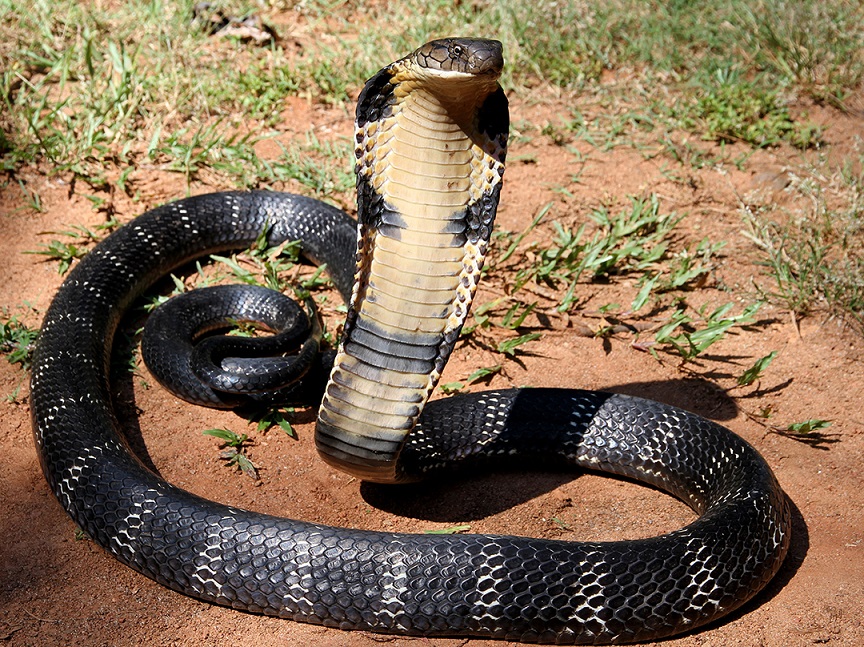 |
| The King Cobra, photo by Michael Allen Smith on Wikimedia commons |
1. Description
1.1. Size
The king cobra is the longest venomous snake in the world with the largest individual recorded at 5.85 m in length. However, adults usually averages between three and four meters[1] . Only snakes from the Pythonidae family, which includes the reticulated python which are known to grow larger than the king cobra in its natural range. The king cobra typically weighs an average of six kilograms. The heaviest wild specimen was measured weighing 12 kg with a total length of 4.77m [2] and was caught at the Island Golf Course, Upper Thomson, Singapore in 1951, though heavier specimens have been recorded in captivity.The king cobra is sometimes confused in the field with the keeled rat snake, Ptyas carinata, which can grow up to 3.6 m but the king cobra can be distinguished by its larger head, smaller eyes and its pair of large occipital scales. The hood of the king cobra will spread when provoked, a feature absent in the keeled rat snake.
1.2. Color and Patterns
| The front and back of a juvenile king cobra. Photo by Biomedicinal in Wikimedia Commons |
Adult king cobras display different colour and pattern variations depending on the locality, raising doubts over the monotypic status of the genus. Adults are recorded to be brown, olive or yellowish. Theodore Cantor in the Journal of the Asiatic society of Bengal[4] noted that the Malayan varieties are lighter, almost yellow in colour than the Indian varieties. Patterns are less distinct when the juvenile patterns disappears in adults. However, adults from Thailand and Burma are known to retain the chevrons and banding[5] . Specific patterns do not occur on the hood unlike the true cobras Naja. The hood however is longer but narrower than the Naja.
1.3. Skull
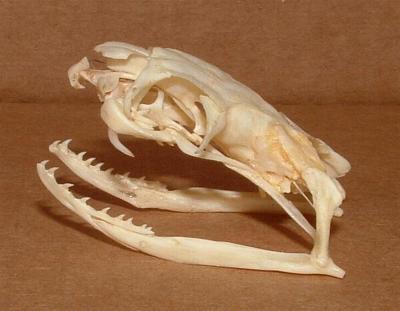 |
| The skull of the king cobra. Photo by Mokele in Wikimedia Commons |
Like all snakes from the family Elapidae, the skull of the king cobra adopts a proteroglyphous or forward-grooved profile. Proteroglyphs have downward pointing fangs at the front of the maxilla (upper jaw) which are hollow and connected to a venom gland. Like all other elapids, the venom of the king cobra is very potent.
1.4. Scales
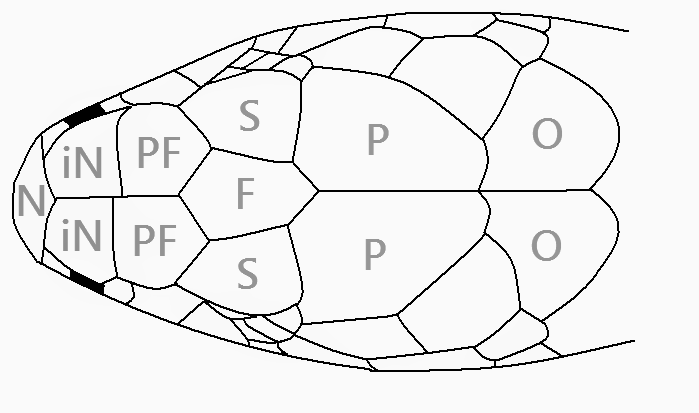 |
| The ventral view of the head scalation of the king cobra. Photo in public domain |
There are 15 rows of dorsal scales The underside has 215–264 ventral scales, with the anal shield entire. There are 80–125 subcaudal scales, with the anterior subcaudal scales single and posterior subcaudal scales paired[6] .
2. Distribution and Habitat
2.1. Habitat
King cobras are terrestrial and semi-arboreal snakes that usually inhabit wet forests, swamps, marshes, shrublands in the wild and nearer to human populations in places such as plantations, rice paddies and even built up areas. Snakes in urban areas still do require access to thick vegetation to hide, hunt and breed. It can climb trees to hunt and rest, as noted by Cantor in his original description of the king cobra in 1836 and also observations of the snake in captivity. The snake is also known to swim. In built up areas, R. Buddle in 1929 observed that the snake have a preference for ‘road drains and culverts’[7] . The snake is found from sea level up to more than 2000 m above sea level[8] .
2.2. Range
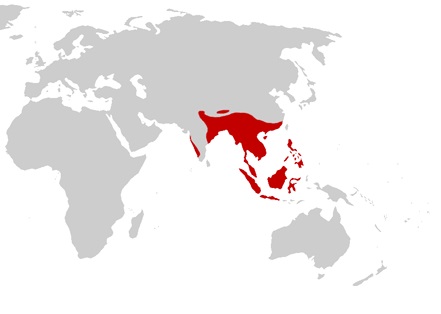 |
| The natural range of the king cobra in Asia |
The snake also inhabits the southern and eastern Chinese provinces of Fujian, Guangdong, Guangxi, Guizhou, Hainan, Hunan, Jiangxi, Sichuan, Tibet, Yunnan, Zhejiang and east in Hong Kong. The snake is found in all countries in Southeast Asia including the Philippines, the large islands of the Indonesian archipelago and Singapore.
2.3. King Cobras in Singapore
The king cobra is native though uncommon in Singapore[11] . It is classified as locally endangered in Singapore by Teo and Rajathurai in 1997[12] and later by Lim et. al. in 2008[13] due to habitat loss and fragmentation and also persecution by humans due to its dangerous reputation. Sightings of the king cobra was first recorded in 1847. Since then reports are widely spaced until the late 20th century, where more incidents are reported and catalogued.
A quick glance at the distribution map of the king cobra in Singapore above shows a large number of reports concentrated within and surrounding the Central Catchment Reserves, incuding the Macritchie Reservoir, Upper Thomson Road, Rifle Range Road, and Bukit Panjang. They have also been caught within the compound of the Singapore Zoo at Mandai Lake Road. In the west, the snake were sighted at Sarimbun Reservoir, around Kranji, Sungei Buloh Wetland Reserve and more recently in the compound of the Nanyang Technological University. The eastern part of the island seemed to be void of king cobra sightings, possibly due to the lack large forest patches common in the central and western Singapore. Full reports of sightings and capture of king cobra from 1847 up to 2010 are listed by Lim et. al. in the Nature in Singapore journal found here
The king cobra have also been sighted on Pulau Tekong, where three reports have been recorded so far. One report was taken from the resort island of Sentosa in 2007, despite lacking large forest patches on the island. Many reports contain juvenile king cobras, proving that breeding does take place here, although no nests have been recorded.
3. Ecology and Behaviour
3.1. Diet
As the name Ophiophagus suggest, the king cobra feeds mainly on other snakes although monitors, other reptiles and amphibians are observed to be eaten. Snakes that are known to be eaten by the king cobra includes the reticulated python, Python reticulatus, other cobras, Naja sp., kraits Bungarus sp. and pit vipers, Trimeresurus sp. In captivity, the king cobra is known to eat snakes not encountered in their native habitat, including the cottonmouth snake, Agkistrodon piscivorus a venomous viper from North America[14] . The king cobra is known to be immune from the venom of the Naja, other Asian snake species and even its own toxin due to antihemorrhagin present in its blood[15] . However, pythons are known to constrict the king cobra to death in self defence, though the python would succumb to the venom a while later if bitten.
The following two videos show the king cobra feeding on other snakes. The video on the left show a king cobra attempting to feed on a large reticulated python, which eventually managed to escape, while the video on the right shows how the king cobra hunting a rat snake and successfully subduing it.
Other reptiles that have been observed to be eaten by the king cobra includes Calotes, Gekko and Varanus. An example of the king cobra's non-snake diet was recorded by Theodore Cantor in his original description of the king cobra where he wrote, “In one I dissected I found remains of a good-sized Monitor, which fact may account for its arboreal habits”[16] . The king cobra is a diurnal snake but can also hunt at night. [17] [18]
3.2. Breeding
The breeding habits of the king cobra are similar to that of the Najas[19] . The king cobra is an oviparous snake, laying eggs instead of giving birth to live snakes. Like the Naja, egg guarding is also practised by the king cobra.The fascinating difference between the king cobra and other snakes is in the habit of building a nest for brooding. The female constructs a nest by coiling its body and tail to pull dead vegetation and soil towards itself. The nest would have two compartments. In the lower compartment, it lays a clutch of between 20-43 eggs, and then coils itself in a compartment above the eggs throughout the period of incubation, which is 10-11 weeks long. It is still not clear whether the presence of the snake on the nest is solely for protection, or whether it serves a thermoregulatory function, or even both. Sometimes the male would be present near the nest. The snake is known to exhibit seasonal monogamy where, in which the male and female would be near each other throughout the mating season which usually starts in April[20] . Parental care is relinquished after the hatching of the eggs. The newborns measure between 28.8 - 42.2 cm long.
3.3. Predators and parasites
The king cobra's main predators are humans who harvest them for food, skin and recreation. Smaller individuals might be hunted by mongooses or birds of preys. Ectoparasites, including ticks and lice are known to prey on snakes, including the king cobra[21] . A study by Barnard and Durden in 2002[22] found six tick species from extracted from the king cobra; Amblyomma cordiferum, Amblyomma helvolum, Aponomma flavomaculatum, A. latum, A. pattoni and A. varanense. The increased international trade of king cobra and other wild reptiles increases the risk of spreading these parasites to new geographic locations, along with the diseases that might be harboured in them.[23]
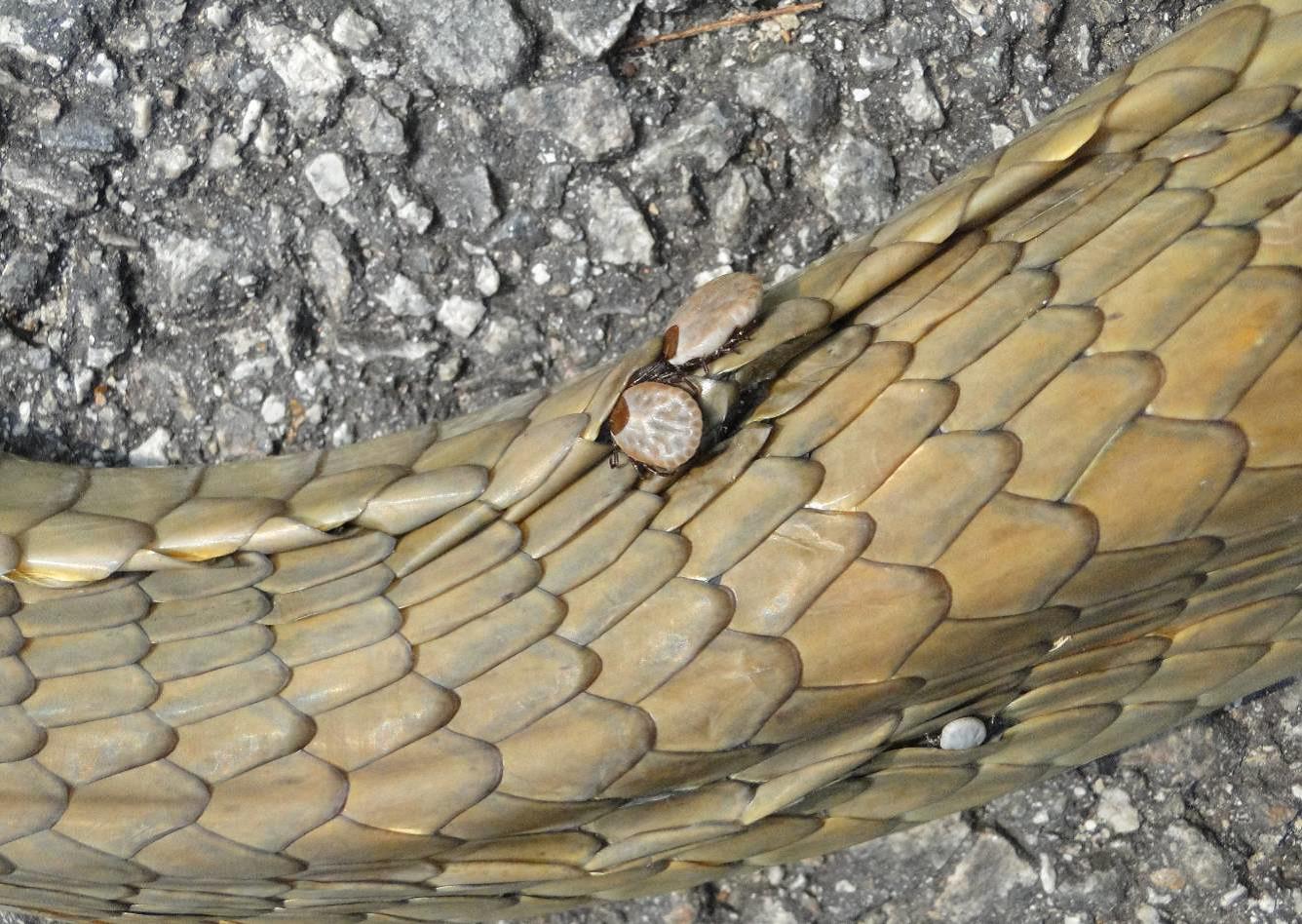 |
| TIcks attached to the skin of the king cobra. Photo by Kim Hong Yi, permission pending |
3.4. Defence
Body enlargement is common defence strategy among animals. This serves as a signal to predators or other potential threats to consider carefully before engaging them and in some animals, to fool potential predators into rejecting a prey of suitable size. Cobras raise the front part of their body and spread the neck ribs to form a hood. The hood may have markings ie. Naja sp. on its back and the cobra may turn and display those markings. Snakes with hoods usually belongs to the genus Naja, aspidelaps and hemachatus and also some species of pseudechis from Australia. Like those cobras, the king cobra could raise its body and spread its hood when threatened.
Another defence mechanism shown by the king cobra is the ability to emit a low frequency growl or hiss when provoked. Bioacoustic studies discovered that the growls of the king cobra averages around 600 Hz, a frequency even lower than of the average human voice[24] . Other snakes in this study vocalized at around 3,000 Hz to 13,000 Hz, significantly higher than of the king cobra. The distinct vocalization of the king cobra is due to its tracheal diverticula that serve as resonating chambers. Besides the king cobra, only the indian rat snake, Ptyas mucosa has the ability to produce similar vocalizations, which potentially serves to mimic the king cobra[25] .
4. Nomenclature and Taxonomy
The genus name Ophiophagus is derived form Greek meaning 'snake-eater', owing to the dietary preference of the species O. hannah, which feeds on other cold-blooded animals including other cobras and pythons. The common name king cobra is coined due to its massive average and maximum length and size relative to other cobra species. The term cobra itself refers to many genus of elapid snakes that can spread their neck ribs to form a hood, which includes the Naja, Aspidelaps and Hemachatus.
Despite being commonly called a cobra, the king cobra belongs to the monotypic genus Ophiophagus and not Naja, the genus of the 'true cobras'. Some taxonomists, even Theodore Cantor, who was the first taxonomist to describe the species had erroneously placed the king cobra into the genus Naja. However morphological and recent phylogenetic studies have proven the divergence of the two genus. Cantor had named the genus Hamadryas but the name is already in use to describe a genus of butterfly by Jacob Hübner in 1806. It was Albert Günther in 1858 who coined the name Ophiophagus, a name which was retained until today.
4.1. Synonyms
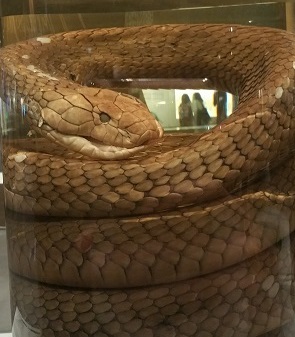 |
| Preserved specimen from LKCMNH. Photo by M. Khairul |
Dendraspis bungarus..................(Schlegel, 1837)*
Dendraspis hannah.....................(Cantor, 1836)
Dendraspis hannah borneensis ..Deraniyagala, 1960
Dendraspis hannah sinensis........Deraniyagala, 1960
Dendraspis hannah brunnea........Deraniyagala, 1961
Dendraspis hannah nordicus........Deraniyagala, 1961
Hamadryas elaps........................ Günther, 1858
Hamadryas hannah......................Cantor, 1836
Hamadryas ophiophagus..............Cantor, 1838
Naja bungarus..............................Schlegel, 1837
Naja hannah.................................(Cantor, 1836)
Naja ingens..................................Van Hasselt, 1882
Naja vittata...................................Elliott, 1840
Naja fasciata................................W.C.H. Peters, 1861
Naja hamadryad..........................Purananda, 1956
Ophiophagus elaps......................(Günther, 1858)
*The brackets surrounding some authors' name is due to the reclassification of the species into another genus by the same author. The names without brackets refers to the original classification of the species.
4.2. Taxonavigation
| Classification |
Rank |
Authority |
| Kingdom |
Animalia |
Linnaeus, 1758 |
| Phylum |
Chordata |
Haeckel, 1874 |
| Class |
Reptilia |
Laurenti, 1768 |
| Order |
Squamata |
Oppel, 1811 |
| Family |
Elapidae |
F. Boie, 1827 |
| Genus |
Ophiophagus |
Cantor, 1836 |
| Species |
O. hannah |
Cantor, 1836 |
4.3. Type information
The holotype of the king cobra, a dry specimen 2.433-2.99 m long[26] is preserved in the British Museum of Natural History under the specimen code BMNH 1996.451. Theodore Cantor described the type locality as “in the Sunderbuns” and “not far from Calcutta”[27] which corresponds to modern day Sundarban region, the delta of the river Ganges which is shared between Bangladesh and the north-eastern Indian state of West Bengal and lies between the latitude 21.5–23°N and 88–91.5°E. Further information on the list of specimens and types can be found here
4.4. Phylogeny
Many phylogenetic studies have been published to determine the placement of genera within the family Elapidae. The family is made up of a large and diverse group of highly venomous terrestrial and marine snakes, with over 60 genera and about 300 species[28] . A comprehensive study was published by Scanlon and Lee in 2004[29] , using 87 external, skeletal, hemipenial, internal anatomy, ecological, chromosomal characters along with the mitochondrial genes cytochrome b and 16S rRNA to establish the phylogenetic relationships between the Elapids. Many other studies concured with Scanlon and Lee that the genus Ophiophagus is distinct and separate from the true cobras Naja.[30] [31]
| A strict consensus tree of 10 equally parsimonious trees found for the combined data. Numbers above lines are Bremer support and Bootstrap percentages (if > 40%), numbers below lines are partitioned Bremer support values for, respectively, morphology, cytochrome b, and 16S rRNA. Groups not found in the consensus tree but with bootstrap support > 40% are indicated on the right (Bremer support 0 or −1). Adapted from Scanlon and Lee (2004). Permission pending |
5. Conservation
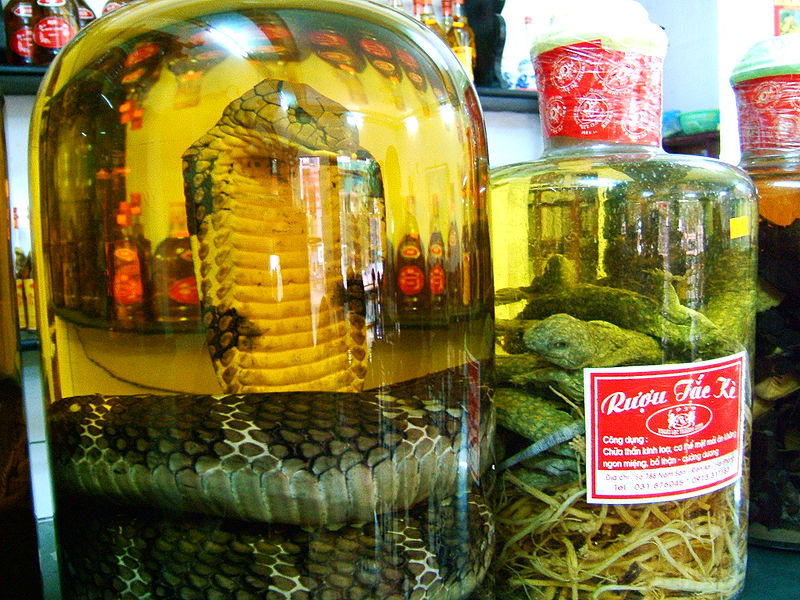 |
| Snake wine made with whole king cobra. Ptoto by Khương Việt Hà in Wikimedia commons |
The king cobra is harvested in the wild for food, use in traditional Chinese medicine and also for its skin[32] . In Vietnam, the snake is used to make snake wine, a medicinal beverage made from submerging whole snake into a container of alcohol. The beverage is popular in parts of Indochina and south China but export to some countries is regulated due to the endangered status of the snake used.
The snake is also popular among private collectors and zoos. The snake is also popular with snake charmers and circus trainers. Major exporters of the king cobra for the pet trade includes Indonesia and Malaysia. Like many forest species, the king cobra is threatened by habitat loss due to logging and agricultural expansion. However, reports of king cobra near human settlements and agricultural land is common throughout its range, proving that it could adapt to living in degraded habitats.
5.1. Status
The king cobra is listed as globally Vulnerable by IUCN, though local assessment in some countries may vary considerably, with China listing the species as Endangered[33] , Critically Endangered in the national Red Data Book for Viet Nam[34] and Near Threatened in India. Further taxonomic study on the species may further delimit the species into a species complex, as suspected by some taxonomist, which will further aggravate the status of each species in the complex.
The king cobra is listed in CITES Appendix II.
6. Useful Links
The king cobra entry on the Encyclopedia of Life
The king cobra entry on the Reptile Database
The king cobra entry on the IUCN Red List
7. References
Tweedie, M. W. F., 1983. The Snakes of Malaya. 3rd Edition. Singapore National Printers (Pte) Ltd., Singapore.
Tweedie, M. W. F., 1983. The Snakes of Malaya. 3rd Edition. Singapore National Printers (Pte) Ltd., Singapore.
Cantor, T., 1847. Catalogue of reptiles inhabiting the Malayan Peninsula and islands. Journal of the Asiatic Society of Bengal, 16: 112–257.
Lim, K. K., T. M. Leong, & F. L. Lim, 2011. The King Cobra, Ophiophagus Hannah (Cantor) In Singapore (Reptilia: Squamata: Elapidae). Nature In Singapore, 4, 143-156.
Buddle, R., 1929. Snakes of Singapore Island. Kelly & Walsh, Ltd., Shanghai. 48 pp.
Wallach, V., K. L. Williams & J. Boundy, 2014.Snakes of the World: A catalogue of living and extinct species. CRC Press.
Lim, K. K. P. & F. L. K. Lim, 1992. A Guide to the Amphibians & Reptiles of Singapore. Singapore Science Centre, Singapore. 160 pp.
Cox, M. J., P. P. van Dijk, J. Nabhitabhata, & K.Thirakhupt, 1998. A photographic guide to snakes and other reptiles of Peninsula Malaysia, Singapore and Thailand. New Holland Publishers (UK) Ltd
Cantor, T.E. 1838. A notice of the Hamadryas, a genus of hooded serpents with poisonous fangs and maxillary teeth. Proceedings of the Zoological Society of London 6(1), 72–75.
Tweedie, M. W. F., 1983. The Snakes of Malaya. 3rd Edition//. Singapore National Printers (Pte) Ltd., Singapore.
Young, B. A., 1991. Morphological basis of “growling” in the king cobra, Ophiophagus hannah.Journal of Experimental Zoology,260(3), 275-287.
Natural History Museum. 2014. Dataset: Collection specimens. Resource: Specimens. http://dx.doi.org/10.5519/0002965 (Retrieved 08 Nov 2015)
Golay, P., H. M. Smith, D. G. Broadley, J. R. Dixon, C. McCarthy, J. C. Rage & Toriba, M. 1993.Endoglyphs and other major venomous snakes of the world: a checklist. Geneva: Azemiops SA Herpetological Data Center.
Stuart, B., G. Wogan, L. Grismer, M. Auliya, R. F. Inger, R. Lilley, T. Chan-Ard, N. Thy, T. Q. Nguyen, C. Srinivasulu & D. Jelić. 2012.Ophiophagus hannah. The IUCN Red List of Threatened Species 2012: e.T177540A1491874.http://dx.doi.org/10.2305/IUCN.UK.2012-1.RLTS.T177540A1491874.en
Wang, S. & Y. Xie. (eds.). 2009. China Species Red List Vol. II - Vertebrates Part 2. Biodiversity Working Group of China Council for International Cooperation on Environment and Development, Beijing.